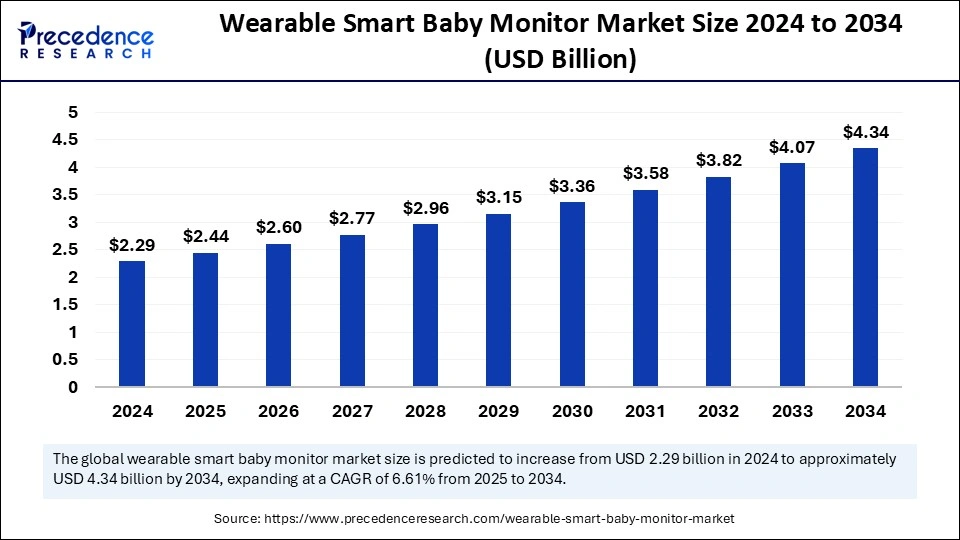Wearable smart baby monitor market size to reach USD 4.34 billion by 2034, up from USD 2.29 billion in 2024, growing at a CAGR of 6.61%

Wearable Smart Baby Monitor Market Key Takeaways
-
In 2024, North America secured the largest market share of 36%, maintaining its dominance.
-
Asia Pacific is projected to be the fastest-growing region in the near future.
-
The Wi-Fi segment was the leading connectivity type in 2024.
-
The Bluetooth segment is poised for rapid expansion in the upcoming years.
-
The audio and video segment captured the largest market share by type in 2024.
-
The video-only segment is forecasted to experience the highest growth rate during the projected period.
-
The two-way audio segment was the top-performing feature in 2024.
-
The motion detection segment is anticipated to witness remarkable growth over the study period.
-
The offline segment led the market in terms of distribution channels in 2024.
-
The online segment is set to grow at the fastest rate in the forthcoming years.
Wearable Smart Baby Monitor Market Overview
The wearable smart baby monitor market is witnessing strong growth as parents increasingly rely on technology to ensure their baby’s safety. These devices are designed to monitor vital health parameters and provide instant alerts in case of irregularities. With the growing preference for real-time data tracking, the adoption of smart baby monitors has surged across both developed and emerging economies.
The increasing integration of artificial intelligence, cloud computing, and IoT-based functionalities is further transforming the industry. In addition, rising concerns over sleep disorders and respiratory conditions in infants are driving the need for continuous health monitoring.
The wearable smart baby monitor market is growing rapidly due to rising concerns about children’s safety that are emerging with the adoption ofsmart home technologies such as smart speakers. Smart baby monitoring systems monitor the baby’s condition 24×7. They measure parameters regarding the baby’s health, such as heartbeat rate and body temperature, that can then be displayed in the mobile application, offering valuable insights into a baby’s development.
The smart baby monitoring system helps parents and caretakers manage time and makes it easier for them to monitor babies’ health remotely. These monitors are extremely efficient in improving children’s safety. Features like motion detection and two-way audio communications enhance safety by enabling parents to stay connected with their children, even from their workplace.
Wearable Smart Baby Monitor Market Drivers
The market is primarily driven by technological advancements in baby monitoring solutions. Improved sensor accuracy, real-time health tracking, and cloud connectivity have enhanced the reliability of these devices. The growing prevalence of working parents seeking remote monitoring solutions is also fueling demand. Rising birth rates in certain regions and increasing awareness regarding SIDS prevention are other key factors contributing to market growth.
Additionally, smart baby monitors are gaining traction in the healthcare sector, with pediatricians recommending them for premature and high-risk infants. The expansion of e-commerce platforms has made these products more accessible to parents worldwide.
Wearable Smart Baby Monitor Market Opportunities
The growing adoption of AI-based baby monitoring software offers lucrative opportunities for manufacturers. These technologies can provide intelligent health insights, detecting anomalies in breathing patterns and heart rates. The expansion of subscription-based baby monitoring services is also creating new revenue streams, allowing parents to access premium monitoring features.
Collaborations between baby monitor brands and hospitals can enable integrated neonatal care solutions, benefiting both consumers and healthcare providers. The rise of multi-functional wearable monitors, which offer not just health tracking but also sleep coaching and environmental monitoring, is another promising trend in the industry.
Wearable Smart Baby Monitor Market Challenges
One of the biggest challenges in the market is data privacy and cybersecurity. As baby monitors become more connected, the risk of hacking and unauthorized access to sensitive data increases. Another key challenge is high manufacturing costs, as premium wearable monitors require advanced sensors and sophisticated software.
Additionally, the reliability of health monitoring data remains a concern, as some devices may generate false alarms or inaccurate readings, causing unnecessary stress for parents. Regulatory compliance in different countries is also a major hurdle, as manufacturers must ensure that their products meet infant safety standards.
Wearable Smart Baby Monitor Market Regional Insights
North America leads the market due to high awareness of digital parenting tools and the widespread adoption of smart home technologies. Europe is another key region, with strong demand driven by stringent baby safety regulations and tech-savvy consumers.
The Asia-Pacific region is expected to witness the fastest growth, particularly in China, India, and Japan, where rising disposable incomes and increasing internet penetration are fueling demand. Latin America and the Middle East are also experiencing growing interest in wearable baby monitors, supported by an expanding middle class and improving digital infrastructure.
Wearable Smart Baby Monitor Market Recent Developments
Manufacturers are focusing on product innovation, launching wearable smart baby monitors with enhanced biometric tracking. New models feature machine learning algorithms that analyze sleep cycles and predict potential health risks. Several companies are also working on non-contact monitoring solutions, which track vital signs without requiring direct skin contact.
Additionally, the market has seen the emergence of affordable smart baby monitors, targeting budget-conscious consumers while maintaining essential health-tracking features. Future advancements may include wearable monitors with personalized health recommendations, further enhancing the value proposition for parents.
Wearable Smart Baby Monitor Market Companies
- Motorola
- Nooie
- Withings
- VTech
- Babysense
- Alecto
- Uniden
- Beurer
- iBaby
- Summer Infant
- Miku
- Owlet
- Arlo
- Angelcare
- Nanit
Segments Covered in the Report
By Connectivity
- Wi-Fi
- Bluetooth
- Cellular
By Type
- Audio Only
- Video Only
- Audio and Video
By Features
- Two-Way Audio
- Night Vision
- Motion Detection
- Temperature and Humidity Monitoring
- Sleep Tracking
By Distribution Channel
- Online
- Offline
By Region
- North America
- Europe
- Asia Pacific
- Middle East & Africa
- Latin America
